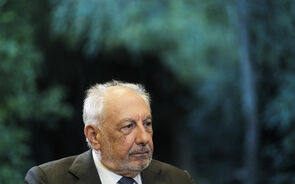Pedido a Ulisses :)
2 mensagens
|Página 1 de 1
O Farley tem escrito, mas eu só transcrevo as coisas que acho mesmo interessantes, quer dele, quer do Cramer, quer dos outros analistas do Realmoney.
Aqui fica o artigo do Task.
Um abraço,
Ulisses
"Terror Fills the News Void"
By Aaron L. Task
TheStreet.com San Francisco Bureau Chief
3/23/2004 7:11 AM EST
"Nature abhors a vacuum. So does Wall Street, judging by recent market action.
The market's "sudden fixation" on terrorism is understandable given recent headlines, but also may be a function of the calendar. With the first quarter coming to a close next week and preparations for regulatory filings under way, many companies are reluctant to make public statements. In the absence of major corporate news, many traders have turned their attention to geopolitical events, which have been grim lately.
The good news for those long on stocks is that negative corporate preannouncements have been relatively modest, suggesting the coming earnings season may provide a catalyst to end this correction.
The end of the market decline seemed far off on Monday, when the Dow Jones Industrial Average fell 1.2% to 10,064.75, the S&P 500 shed 1.3% to 1095.44 and the Nasdaq Composite tumbled 1.6% to 1909.91. Fear of reprisals after the Israeli assassination of Hamas' founder was widely cited as spurring the decline, along with the controversy over the Taiwanese elections and Richard Clarke's critical comments about President Bush on TV's "60 Minutes."
Each of the major averages ended Monday below the intraday lows set on March 16 and were at their lowest closing levels since December. That's a negative technical development and suggests another test of the indices' simple 200-day moving averages could be forthcoming. At the start of the week, those averages stood at around 9799 for the Dow, 1054.59 for the S&P and 1886 for the Nasdaq.
One theory is that major averages will continue to struggle, most likely coming down to test, and possibly breach, those 200-day moving averages in the coming days or weeks. It's easy to envision a scenario with more weakness leading to more equity outflows -- AMG Data reported $22 million came out of equity funds for the week ended March 17 -- particularly if the Dow falls under the headline-generating 10,000 level. Historically, mutual fund investors have been bad market timers and may head for the exits in larger numbers just as stocks get primed to rebound in concert with the release of first-quarter earnings.
It seems almost too pat that technical analysis -- a test of the 200-day moving averages -- will intersect so precisely with fundamental developments -- first-quarter earnings.
But the current backdrop makes such a scenario plausible.
Notably, preannouncements "have been running somewhat more negative than [the fourth quarter] at this time, but better than a year ago and compared to the long-term average," according to Joe Cooper, research analyst at Thomson First Call. The ratio of negative-to-positive preannouncements is 1.8 vs. 1.3 last quarter but down from 2.7 a year ago, he noted.
Despite negative restatements from companies such as Veritas (VRTS:Nasdaq - commentary - research), Bristol-Myers Squibb (BMY:NYSE - commentary - research) and Nortel (NT:NYSE - commentary - research), "the favorable preannouncement environment has led to upward revisions to [earnings] estimates," Cooper wrote.
Industry analysts now expect year-over-year S&P 500 profit growth of 15.9% vs. 13.4% on Jan. 1. First Call believes growth may ultimately come in at 19%, based partially on the strong reports last week from brokerage firms. Continued optimism about corporate profits suggests the recent decline is more about technical phenomena and the emotions that arise in a news vacuum vs. veritable fundamental concerns.
The point isn't to underestimate the significance of geopolitical developments, but to note that equities rallied mightily in 2003 despite a string of terrorist attacks in Turkey, Saudi Arabia and Iraq. Sadly but surely, the market's next rally won't occur because the terrorism threat has been eradicated.
The Long and Short of It
While the short-term outlook remains dicey, most market watchers believe stocks are attractive on a longer-term basis, especially when compared with still-slim Treasury yields. Valuing stocks against corporate bonds is arguably fairer, but many institutional investors remain faithful to the so-called Fed model, which compares the earnings yield of the S&P 500 (the inverse of the price-to-earnings ratio) to yields on the 10-year Treasury note. By that metric, stocks remain undervalued relative to Treasuries, which rallied Monday. (The price of the benchmark 10-year note rose 15/32 to 102 11/32, its yield falling to 3.71%.)
Optimists further contend the economy remains strong, corporate profits are robust and the Federal Reserve is unlikely to raise rates this year, a bullish backdrop for equities.
Pessimists disagree. "Tremendously positive profit news is already built in" to shares, says Vadim Zlotnikov, chief investment strategist at Sanford C. Bernstein. He acknowledged that more than half of S&P sectors are expected to have their highest profitability in history in the coming year, based on current First Call estimates. But the stock market tends to look forward and is "beginning to realize unless corporations get some pricing power, we're facing a stark choice between employment growth and margin expansion," he said.
That said, Zlotnikov agreed the recent weakness is "a lot less about near-term fundamentals" and a lot more about the absence of fundamental news.
Furthermore, there's some evidence that the recent selling is approaching a climax. The one-day Arms Index soared 70% Monday to 3.35 after a recent string of three straight days over 2.35, something that hadn't occurred since 1953. (Also know as the TRIN, the Arms Index is a ratio of a ratio -- comparing the number of rising stocks to the number of declining stocks at a given time and simultaneously relating that comparison to advancing and declining volume.)
Put/call ratios and other fear gauges have also been rising of late. Also, 91% of New York Stock Exchange volume and 87% of over-the-counter trades were to the downside Monday. A week ago, the figures were almost exactly reversed.
Such extremes in downside volume typically occur near the end of market reversals, as detailed in the research of Paul Desmond, president of Lowry's Reports.
However, Desmond's work dictates volume and price action must both exceed the 90% threshold (on either exchange) to complete a 90% downside day. (Desmond couldn't be reached Monday but in the past has said he's unaware of any way to calculate price action other than to accumulate all price moves for all stocks, which is why the information isn't typically available until the following day.)
Furthermore, Desmond's works shows there are historically a series of 90% downside days before major bottoms occur. The point being that it's a bit too early to begin actively positioning for a rebound, even if the coming earnings season offers a light at the end of the market's downward tunnel vision."
(in www.realmoney.com)
Aqui fica o artigo do Task.
Um abraço,
Ulisses
"Terror Fills the News Void"
By Aaron L. Task
TheStreet.com San Francisco Bureau Chief
3/23/2004 7:11 AM EST
"Nature abhors a vacuum. So does Wall Street, judging by recent market action.
The market's "sudden fixation" on terrorism is understandable given recent headlines, but also may be a function of the calendar. With the first quarter coming to a close next week and preparations for regulatory filings under way, many companies are reluctant to make public statements. In the absence of major corporate news, many traders have turned their attention to geopolitical events, which have been grim lately.
The good news for those long on stocks is that negative corporate preannouncements have been relatively modest, suggesting the coming earnings season may provide a catalyst to end this correction.
The end of the market decline seemed far off on Monday, when the Dow Jones Industrial Average fell 1.2% to 10,064.75, the S&P 500 shed 1.3% to 1095.44 and the Nasdaq Composite tumbled 1.6% to 1909.91. Fear of reprisals after the Israeli assassination of Hamas' founder was widely cited as spurring the decline, along with the controversy over the Taiwanese elections and Richard Clarke's critical comments about President Bush on TV's "60 Minutes."
Each of the major averages ended Monday below the intraday lows set on March 16 and were at their lowest closing levels since December. That's a negative technical development and suggests another test of the indices' simple 200-day moving averages could be forthcoming. At the start of the week, those averages stood at around 9799 for the Dow, 1054.59 for the S&P and 1886 for the Nasdaq.
One theory is that major averages will continue to struggle, most likely coming down to test, and possibly breach, those 200-day moving averages in the coming days or weeks. It's easy to envision a scenario with more weakness leading to more equity outflows -- AMG Data reported $22 million came out of equity funds for the week ended March 17 -- particularly if the Dow falls under the headline-generating 10,000 level. Historically, mutual fund investors have been bad market timers and may head for the exits in larger numbers just as stocks get primed to rebound in concert with the release of first-quarter earnings.
It seems almost too pat that technical analysis -- a test of the 200-day moving averages -- will intersect so precisely with fundamental developments -- first-quarter earnings.
But the current backdrop makes such a scenario plausible.
Notably, preannouncements "have been running somewhat more negative than [the fourth quarter] at this time, but better than a year ago and compared to the long-term average," according to Joe Cooper, research analyst at Thomson First Call. The ratio of negative-to-positive preannouncements is 1.8 vs. 1.3 last quarter but down from 2.7 a year ago, he noted.
Despite negative restatements from companies such as Veritas (VRTS:Nasdaq - commentary - research), Bristol-Myers Squibb (BMY:NYSE - commentary - research) and Nortel (NT:NYSE - commentary - research), "the favorable preannouncement environment has led to upward revisions to [earnings] estimates," Cooper wrote.
Industry analysts now expect year-over-year S&P 500 profit growth of 15.9% vs. 13.4% on Jan. 1. First Call believes growth may ultimately come in at 19%, based partially on the strong reports last week from brokerage firms. Continued optimism about corporate profits suggests the recent decline is more about technical phenomena and the emotions that arise in a news vacuum vs. veritable fundamental concerns.
The point isn't to underestimate the significance of geopolitical developments, but to note that equities rallied mightily in 2003 despite a string of terrorist attacks in Turkey, Saudi Arabia and Iraq. Sadly but surely, the market's next rally won't occur because the terrorism threat has been eradicated.
The Long and Short of It
While the short-term outlook remains dicey, most market watchers believe stocks are attractive on a longer-term basis, especially when compared with still-slim Treasury yields. Valuing stocks against corporate bonds is arguably fairer, but many institutional investors remain faithful to the so-called Fed model, which compares the earnings yield of the S&P 500 (the inverse of the price-to-earnings ratio) to yields on the 10-year Treasury note. By that metric, stocks remain undervalued relative to Treasuries, which rallied Monday. (The price of the benchmark 10-year note rose 15/32 to 102 11/32, its yield falling to 3.71%.)
Optimists further contend the economy remains strong, corporate profits are robust and the Federal Reserve is unlikely to raise rates this year, a bullish backdrop for equities.
Pessimists disagree. "Tremendously positive profit news is already built in" to shares, says Vadim Zlotnikov, chief investment strategist at Sanford C. Bernstein. He acknowledged that more than half of S&P sectors are expected to have their highest profitability in history in the coming year, based on current First Call estimates. But the stock market tends to look forward and is "beginning to realize unless corporations get some pricing power, we're facing a stark choice between employment growth and margin expansion," he said.
That said, Zlotnikov agreed the recent weakness is "a lot less about near-term fundamentals" and a lot more about the absence of fundamental news.
Furthermore, there's some evidence that the recent selling is approaching a climax. The one-day Arms Index soared 70% Monday to 3.35 after a recent string of three straight days over 2.35, something that hadn't occurred since 1953. (Also know as the TRIN, the Arms Index is a ratio of a ratio -- comparing the number of rising stocks to the number of declining stocks at a given time and simultaneously relating that comparison to advancing and declining volume.)
Put/call ratios and other fear gauges have also been rising of late. Also, 91% of New York Stock Exchange volume and 87% of over-the-counter trades were to the downside Monday. A week ago, the figures were almost exactly reversed.
Such extremes in downside volume typically occur near the end of market reversals, as detailed in the research of Paul Desmond, president of Lowry's Reports.
However, Desmond's work dictates volume and price action must both exceed the 90% threshold (on either exchange) to complete a 90% downside day. (Desmond couldn't be reached Monday but in the past has said he's unaware of any way to calculate price action other than to accumulate all price moves for all stocks, which is why the information isn't typically available until the following day.)
Furthermore, Desmond's works shows there are historically a series of 90% downside days before major bottoms occur. The point being that it's a bit too early to begin actively positioning for a rebound, even if the coming earnings season offers a light at the end of the market's downward tunnel vision."
(in www.realmoney.com)
Pedido a Ulisses :)
Bom dia 
Seria possivel publicar o artigo do Task q está no Realmoney?
Tks in advance
O Farley n tem escrito?
abraço
Seria possivel publicar o artigo do Task q está no Realmoney?
Tks in advance
O Farley n tem escrito?
abraço
2 mensagens
|Página 1 de 1
Quem está ligado:
Utilizadores a ver este Fórum: Bing [Bot], Google [Bot], latbal, LCRLCR, lito, m-m, malakas, Manchini888, Masterchief, maturidade, MR32, nunorpsilva, O Magriço, OCTAMA, Rui Nascimento1971, trilhos2006 e 134 visitantes



